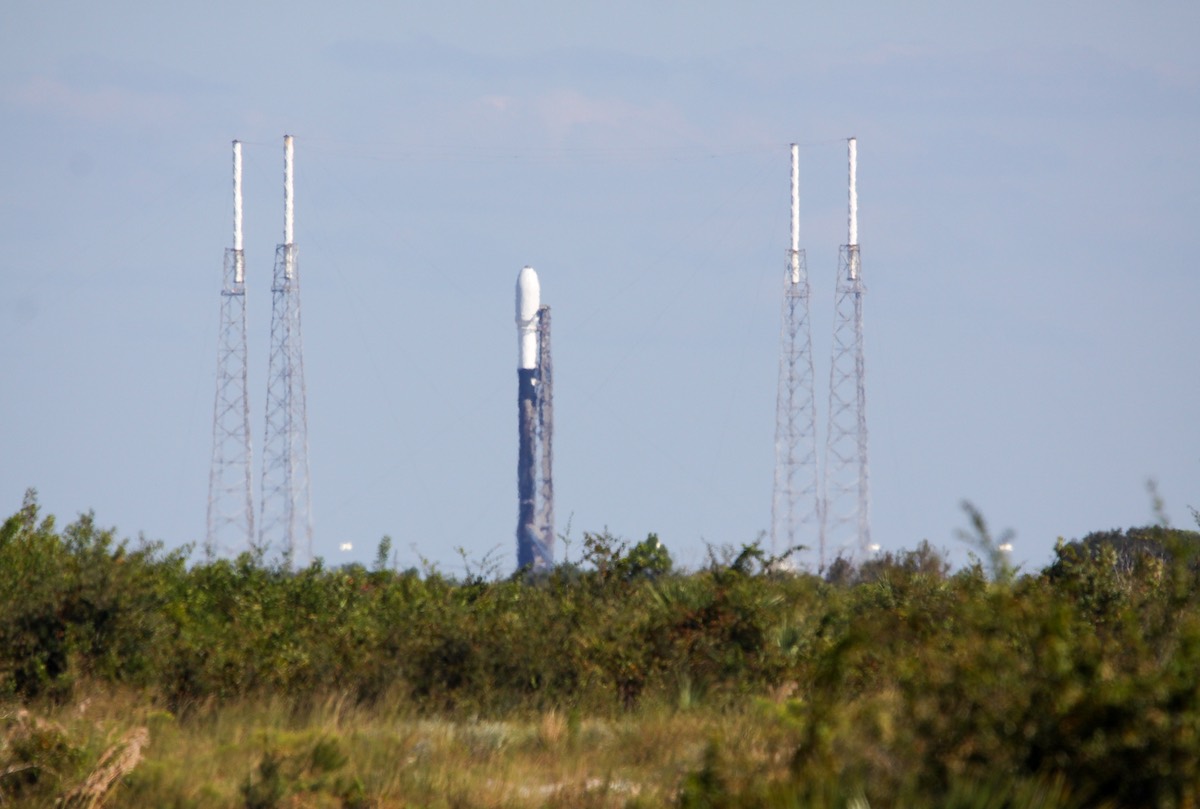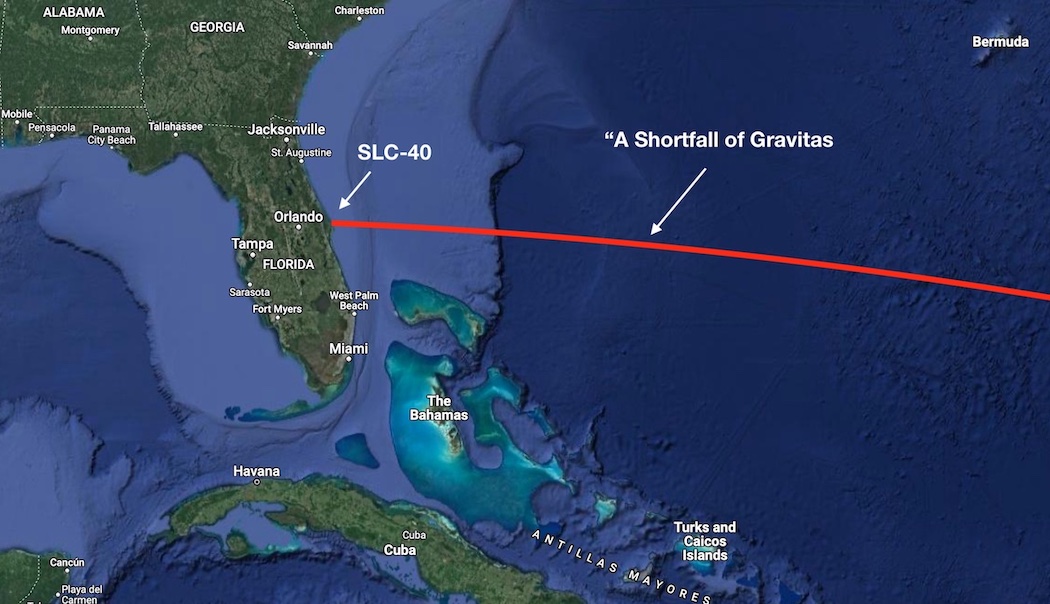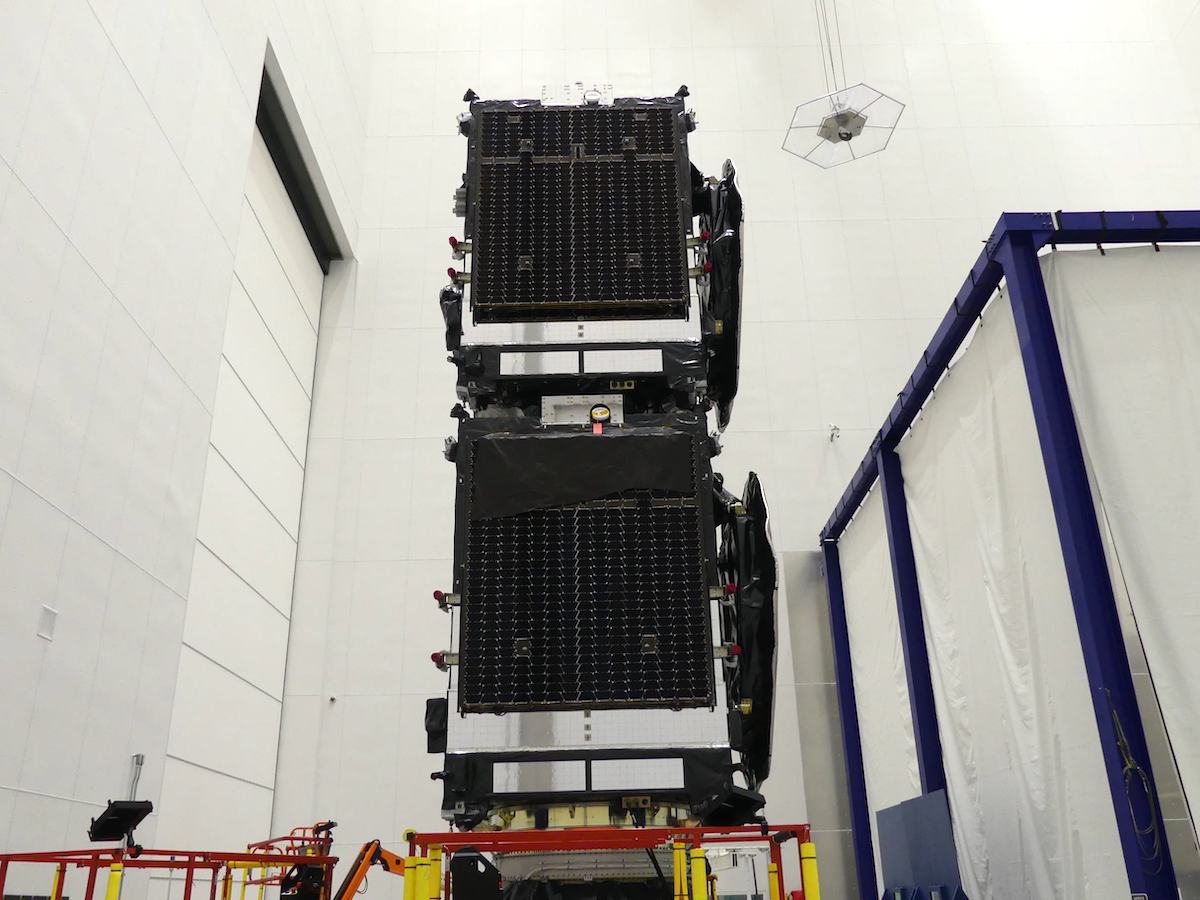Space News & Blog Articles
Live coverage: Falcon 9 rocket ready to launch two Intelsat telecom satellites
Live coverage of the countdown and launch of a SpaceX Falcon 9 rocket from Space Launch Complex 40 at Cape Canaveral Space Force Station, Florida. The Falcon 9 rocket will launch Intelsat’s Galaxy 33 and Galaxy 34 geostationary communications satellites. Follow us on Twitter.
SFN Live
A pair of TV broadcasting satellites for Intelsat are buttoned up for launch aboard a SpaceX Falcon 9 rocket from Cape Canaveral at 7:07 p.m. EDT (2307 GMT), the third launch from the Florida spaceport in three days.
SpaceX has a 67-minute launch window Thursday night, and the launch weather officer predicts a greater than 90% chance of favorable weather for liftoff. The launch window opens a few minutes after sunset, and with clear skies expected, spectators could have dazzling views of the Falcon 9 climbs into space at twilight.
The launch Thursday night will be the third flight of a Falcon 9 rocket in less than a day-and-a-half, following a Falcon 9 launch at noon EDT (1600 GMT) Wednesday from pad 39A at Kennedy Space Center carrying a four-person crew to the International Space Station. Then SpaceX launched a Falcon 9 rocket from Vandenberg Space Force Base in California at 7:10 p.m. EDT (4:10 p.m. PDT; 2310 GMT) Wednesday with 52 Starlink internet satellites, just seven hours after the astronaut launch from Florida.
Now, a few miles south of Kennedy Space Center, SpaceX personnel are preparing a Falcon 9 rocket for launch from pad 40 on a commercial flight for Intelsat.
SpaceX’s mission for Intelsat Thursday will also be the third space launch from Florida’s Space Coast in three days. An Atlas 5 rocket from United Launch Alliance kicked off the string of launches from Cape Canaveral on Tuesday with a commercial satellite delivery mission for SES.
The Galaxy 33 and 34 satellites are setting off on 15-year missions to relay C-band video and television programming for media networks and cable providers across North America. They will replace two aging Intelsat satellites, Galaxy 12 and Galaxy 15, that have been in space since 2003 and 2005.
SpaceX ground crews rolled the Falcon 9 rocket and its commercial satellite payload to pad 40 earlier this week, and raised it vertical in the launch mount at pad 40 for final checkouts early Thursday. The 229-foot-tall (70-meter) launcher will be filled with a million pounds of kerosene and liquid oxygen propellants in the final 35 minutes of the countdown.
After teams verify technical and weather parameters are all “green” for launch, the nine Merlin 1D main engines on the first stage booster will flash to life with the help of an ignition fluid called triethylaluminum/triethylborane, or TEA-TEB. Once the engines ramp up to full throttle, hydraulic clamps will open to release the Falcon 9 for its climb into space.
The nine main engines will produce 1.7 million pounds of thrust for about two-and-a-half minutes, propelling the Falcon 9 and Intelsat’s Galaxy 33 and Galaxy 34 communications satellite into the upper atmosphere. Then the booster stage — tail number B1060 in SpaceX’s fleet — will shut down and separate from the Falcon 9’s upper stage.
 SpaceX’s Falcon 9 rocket standing on pad 40 at Cape Canaveral Space Force Station before launch of the Galaxy 33 and 34 satellites. Credit: Stephen Clark / Spaceflight Now
SpaceX’s Falcon 9 rocket standing on pad 40 at Cape Canaveral Space Force Station before launch of the Galaxy 33 and 34 satellites. Credit: Stephen Clark / Spaceflight Now
The booster will extend titanium grid fins and pulse cold gas thrusters to orient itself for a tail-first entry back into the atmosphere, before reigniting its engines for a braking burn and a final landing burn, targeting a vertical descent to the drone ship “A Shortfall of Gravitas” parked about 400 miles (about 640 kilometers) east of Cape Canaveral.
A successful landing would mark the completion of the booster’s 14th flight to space, tying another Falcon 9 booster as SpaceX’s fleet leaders.
SpaceX has already successfully launched a mission with a booster making its 14th flight to space, but that launch carried a batch of the company’s own Starlink internet satellites. The mission for Intelsat on Thursday night will be the first time SpaceX has launched a booster with more than 10 flights on a dedicated flight for a customer.
“It’s the same price if you’re the first or the 14th,” said Jean-Luc Froeliger, Intelsat’s senior vice president of space systems.
SpaceX has qualified its reusable Falcon 9 boosters for at least 15 missions, up from the 10-mission goal the company stated when it debuted the Block 5 booster — the latest iteration of the Falcon 9 — in 2018, the trade magazine Aviation Week & Space Technology reported in June.
The magazine reported SpaceX put booster components through vibration testing to four times the fatigue life of what they would experience over 15 flights, giving engineers confidence that the rockets will continue to fly successfully.
“They’re very impressive,” Froeliger, a longtime satellite industry manager, said of SpaceX. “They have found a model where their reusable first stage and reusable fairing allow them to launch on a very rapid cadence, they have two launch complexes here, plus Vandenberg. So yes, they get a lot of business.”
Froeliger said SpaceX’s Falcon 9 launcher is the “workhorse of the industry” after SpaceX pioneered recovery and reuse of commercial rockets. The company has launched 45 times so far this year, far outpacing any of its rivals in the launch business.
 This map illustrates the predicted ground track for the Falcon 9 rocket on the SES 22 mission, with the locations of pad 40 and the drone ship “A Shortfall of Gravitas” labeled. Credit: Spaceflight Now
This map illustrates the predicted ground track for the Falcon 9 rocket on the SES 22 mission, with the locations of pad 40 and the drone ship “A Shortfall of Gravitas” labeled. Credit: Spaceflight Now
On Thursday’s mission, the Falcon 9 rocket will fire its upper stage engine two times to inject the Galaxy 33 and 34 spacecraft into an elliptical “sub-synchronous” transfer orbit with an apogee, or high point, short of the satellites’ final 22,000-mile-high operating altitude in geostationary orbit.
The lower-than-usual deployment orbit for a geostationary mission allows the Falcon 9 rocket to lift both satellites on one mission, and gives the Falcon 9’s reusable first stage booster enough reserve propellant to return to landing on a drone ship in the Atlantic Ocean.
Galaxy 33 and 34 will separate from the Falcon 9 rocket one at a time about 33 minute and 38 minutes into the mission.
“They’re bolted on top of each other and encapsulated inside the fairing,” Froeliger said. “At separation, it’s actually the upper satellite that separates from the lower satellite first. So Galaxy 33 will be separated from the lower satellite by firing a pyrotechnic device to release a clamp band that maintains the two satellites together. Once Galaxy 33 separates, then Galaxy 34 separates from the launch vehicle.”
The dual satellites have a combined weight of about 16,200 pounds (7,350 kilograms), according to Northrop Grumman, which manufactured Galaxy 33 and 34.
The spacecraft will use their own hydrazine-fueled engines to raise their orbit to geostationary altitude. The orbit-raising maneuvers will take about 10 to 11 days, Froeliger said.
The two satellites are similar, but not identical. Galaxy 33 carries a C-band communications payload, plus steerable Ka-band and Ku-band beams. Galaxy 34 is a dedicated C-band relay satellite for video relay services.
Galaxy 33 will replace the Galaxy 15 communications satellite in an operating position at 133 degrees West longitude. Intelsat lost control of Galaxy 15 in August after it was likely damaged during a geomagnetic storm, the company said. Galaxy 15 was already due for replacement before Intelsat lost contact with spacecraft.
Intelsat plans to deploy the Galaxy 34 satellite to 129 degrees West longitude, where it will replace Galaxy 12.
The Galaxy 33 and 34 satellites are the first two of seven planned Intelsat satellites to replenish the company’s fleet of C-band television broadcast satellites, replacing C-band capacity being transitioned to 5G cellular network services by the Federal Communications Commission. The remaining C-band replacement satellites will launch on a mix of Falcon 9 and Ariane 5 rockets.
 The Galaxy 33 and Galaxy 34 (top and bottom) satellites stacked in launch configuration at SpaceX’s payload processing facility at Cape Canaveral Space Force Station. Credit: Intelsat
The Galaxy 33 and Galaxy 34 (top and bottom) satellites stacked in launch configuration at SpaceX’s payload processing facility at Cape Canaveral Space Force Station. Credit: Intelsat
ROCKET: Falcon 9 (B1060.14)
PAYLOAD: Galaxy 33 and 34 communications satellites
LAUNCH SITE: SLC-40, Cape Canaveral Space Force Station, Florida
LAUNCH DATE: Oct. 6, 2022
LAUNCH WINDOW: 7:07-8:14 p.m. EDT (2307-0014 GMT)
WEATHER FORECAST: Greater than 90% probability of acceptable weather
BOOSTER RECOVERY: “A Shortfall of Gravitas” drone ship
LAUNCH AZIMUTH: East
TARGET ORBIT: Sub-synchronous transfer orbit
LAUNCH TIMELINE:
T+00:00: Liftoff T+01:12: Maximum aerodynamic pressure (Max-Q) T+02:33: First stage main engine cutoff (MECO) T+02:37: Stage separation T+02:41: Second stage engine ignition T+03:25: Fairing jettison T+06:27: First stage entry burn ignition (three engines) T+06:48: First stage entry burn ends T+08:15: Second stage engine cutoff (SECO 1) T+08:18: First stage landing burn ignition (one engine) T+08:40: First stage landing T+26:19: Second stage engine restart T+27:06: Second stage engine cutoff (SECO 2) T+32:57: Galaxy 33 separation T+38:07: Galaxy 34 separationMISSION STATS:
180th launch of a Falcon 9 rocket since 2010 188th launch of Falcon rocket family since 2006 14th launch of Falcon 9 booster B1060 154th Falcon 9 launch from Florida’s Space Coast 99th Falcon 9 launch from pad 40 154th launch overall from pad 40 121st flight of a reused Falcon 9 booster 2nd SpaceX launch for Intelsat 46th Falcon 9 launch of 2022 46th launch by SpaceX in 2022 44th orbital launch attempt based out of Cape Canaveral in 2022This email address is being protected from spambots. You need JavaScript enabled to view it. the author.
Follow Stephen Clark on Twitter: @StephenClark1.
When you subscribe to the SpaceZE News Feed, we will send you an e-mail when there are new updates on the site so you wouldn't miss them.

